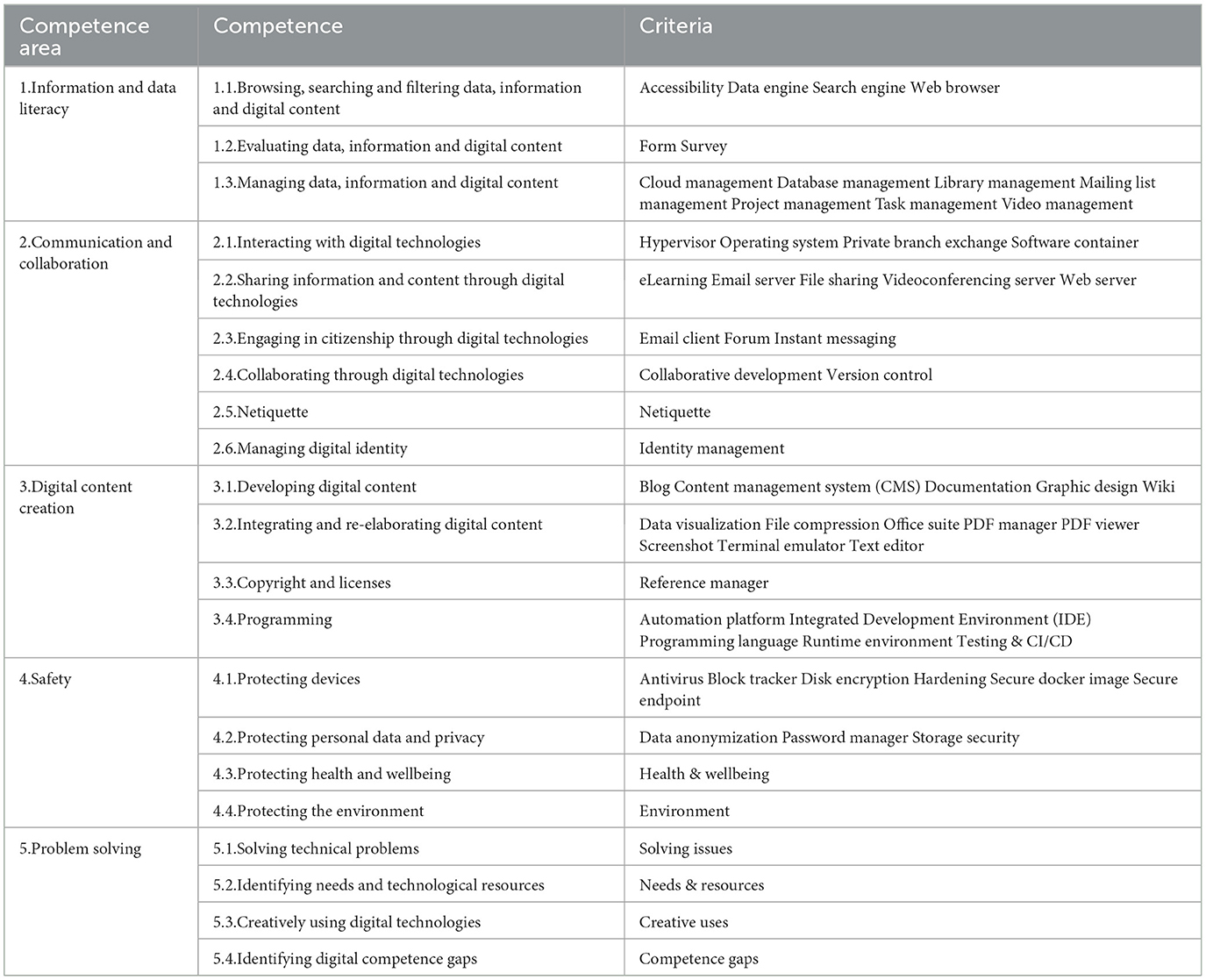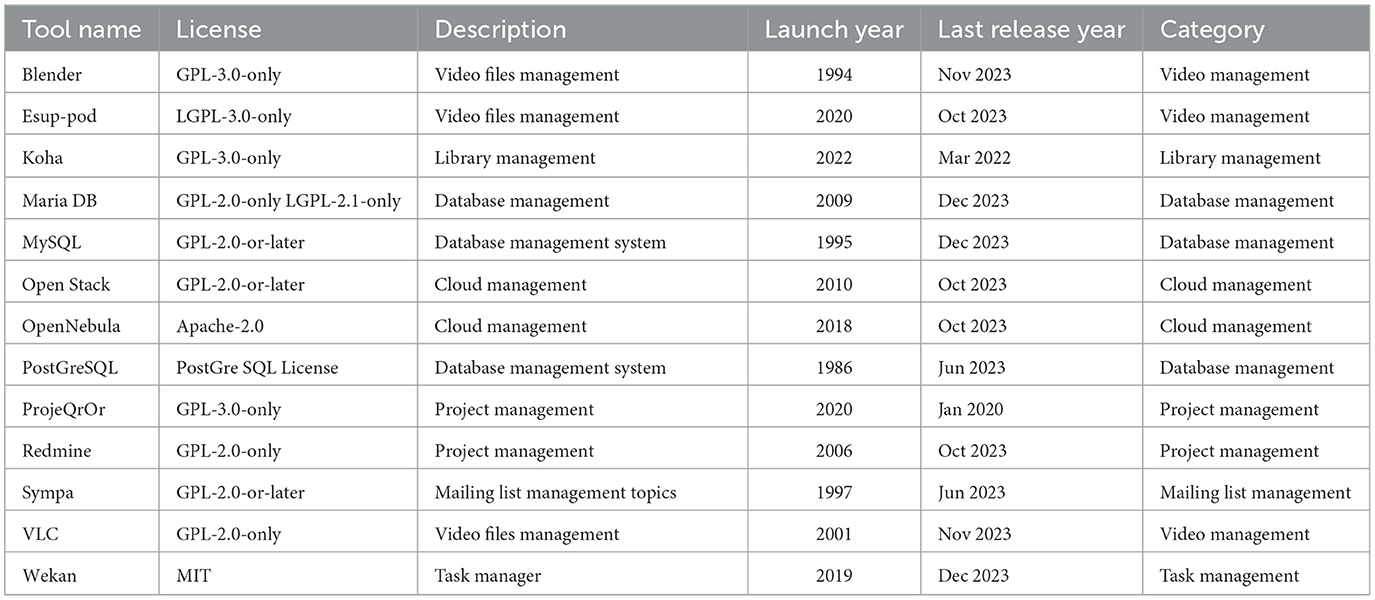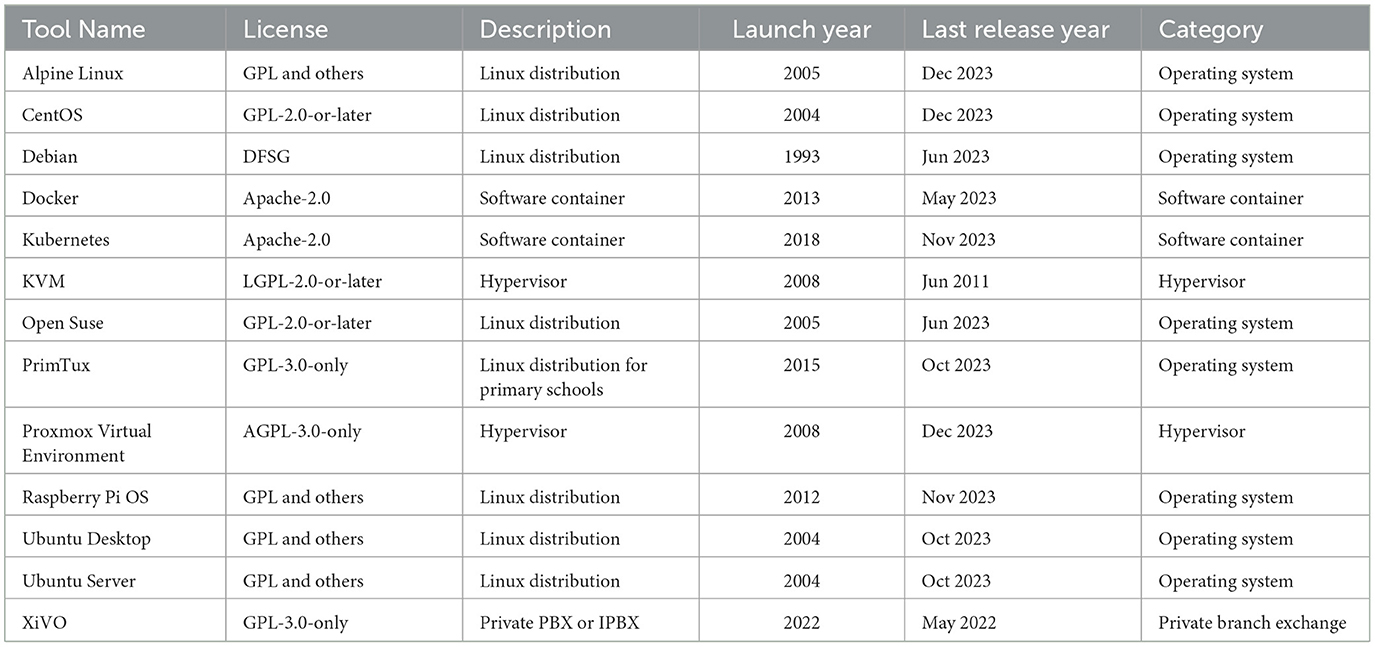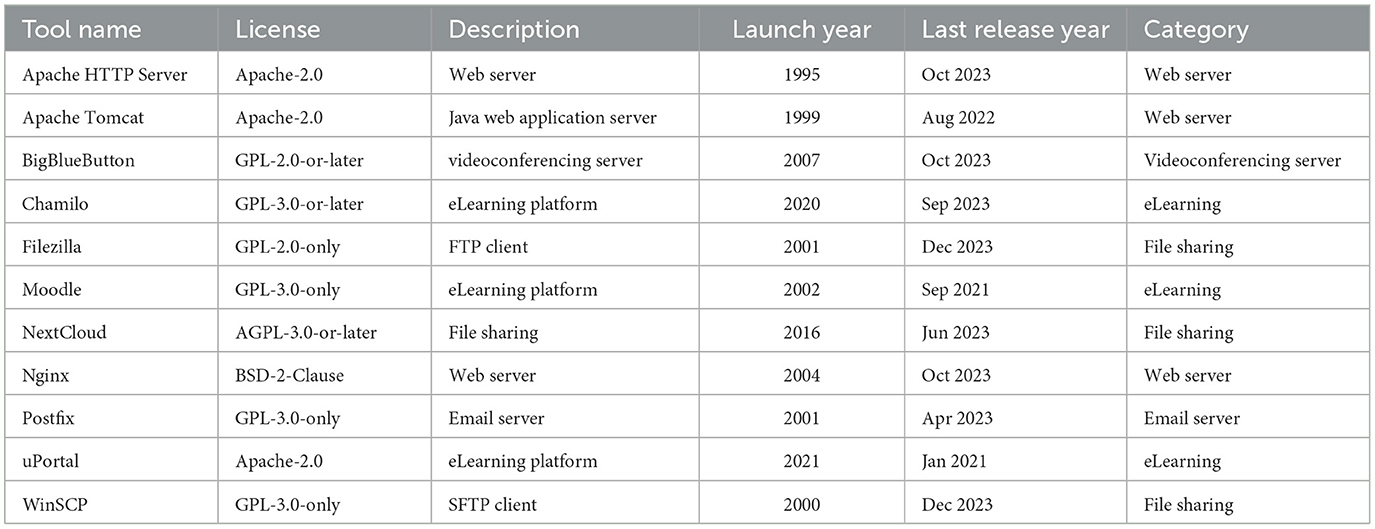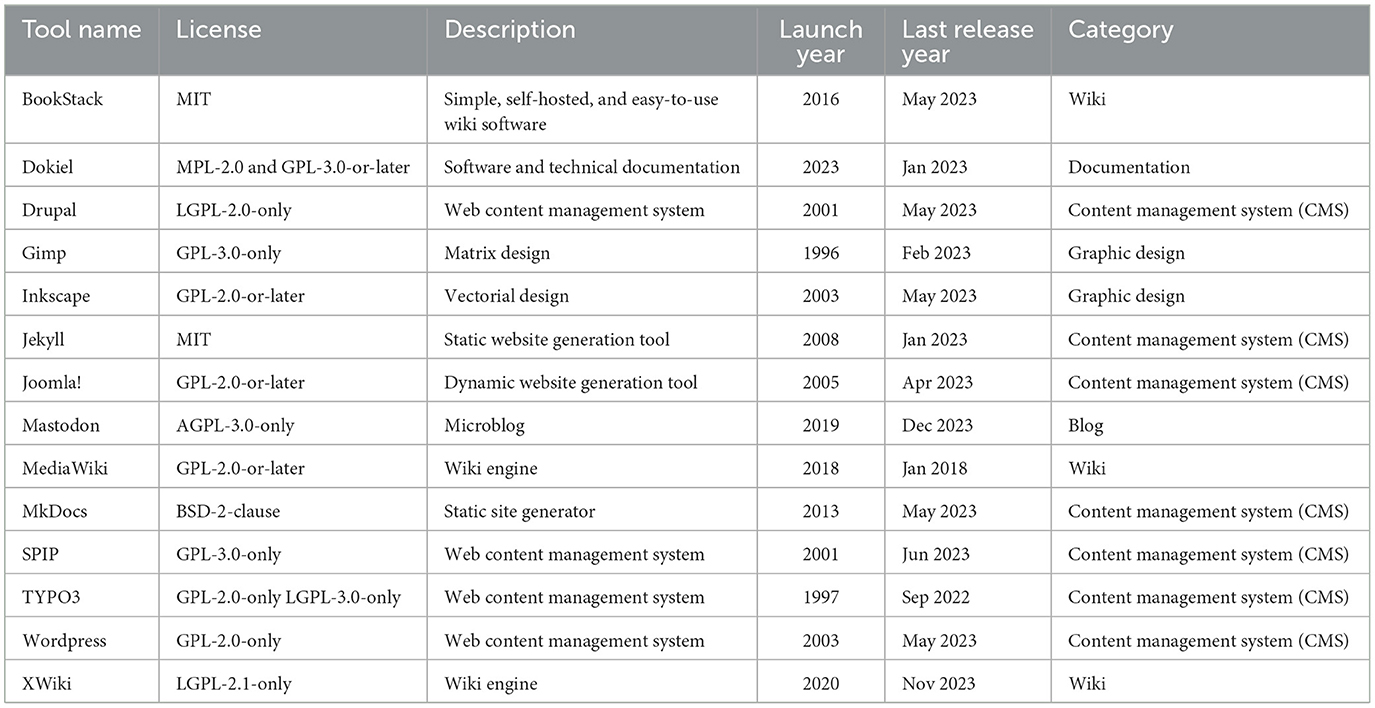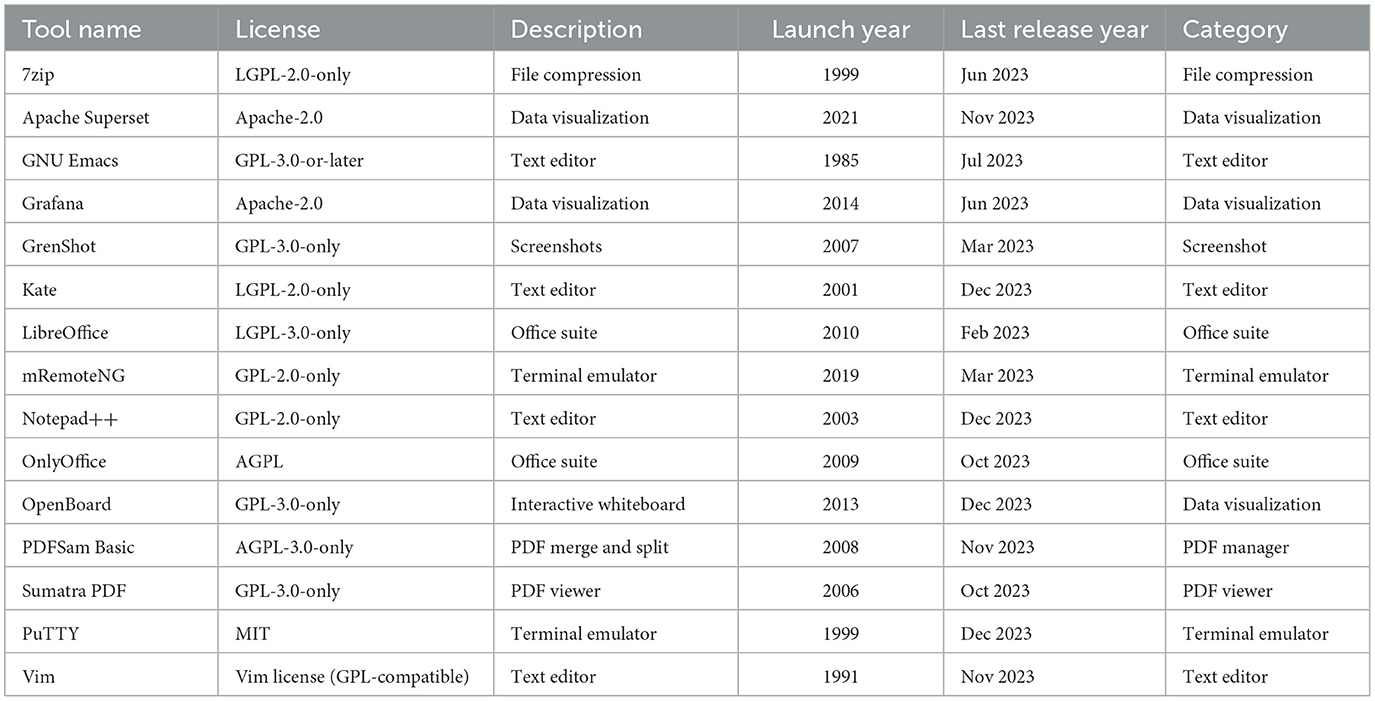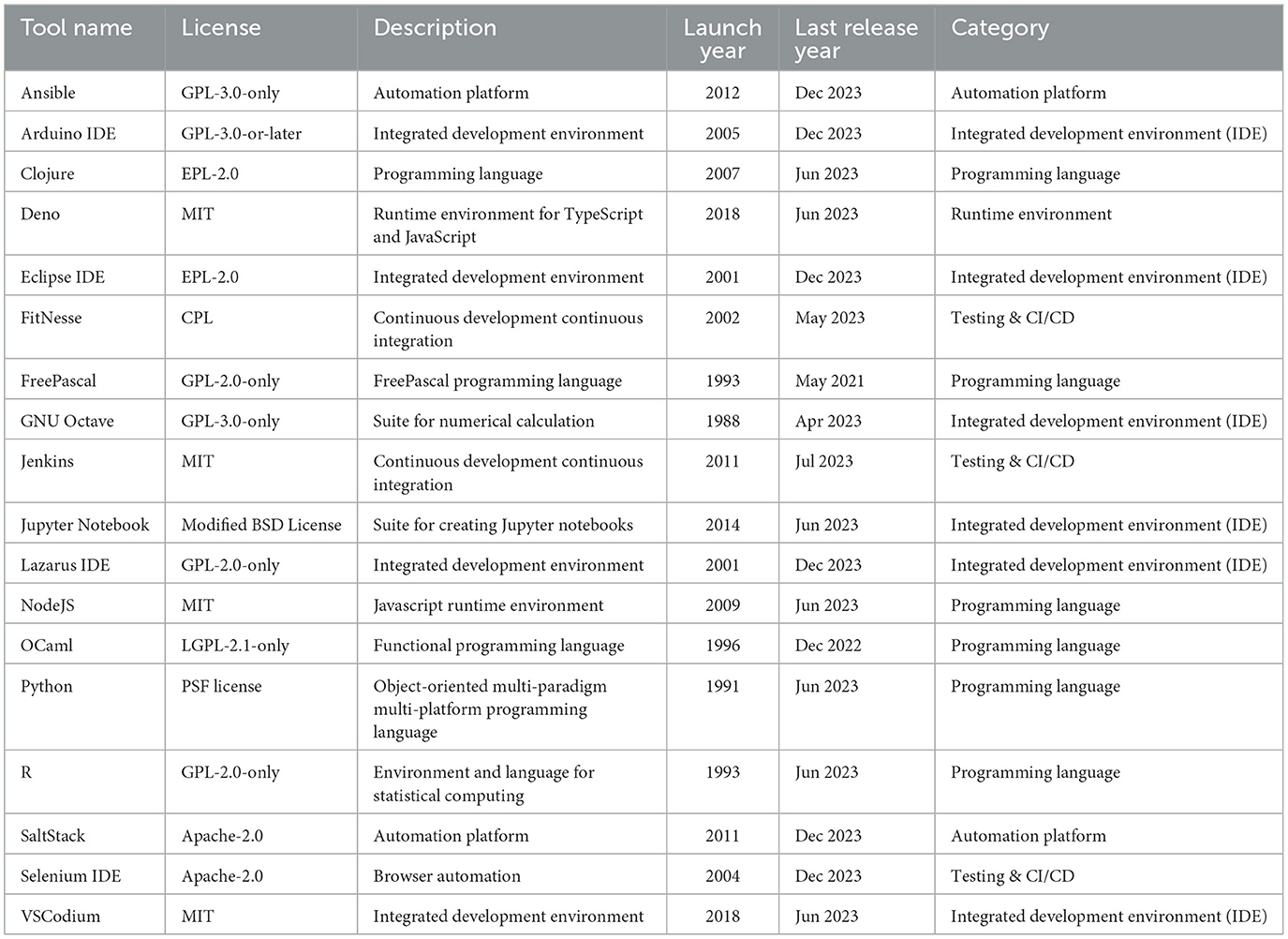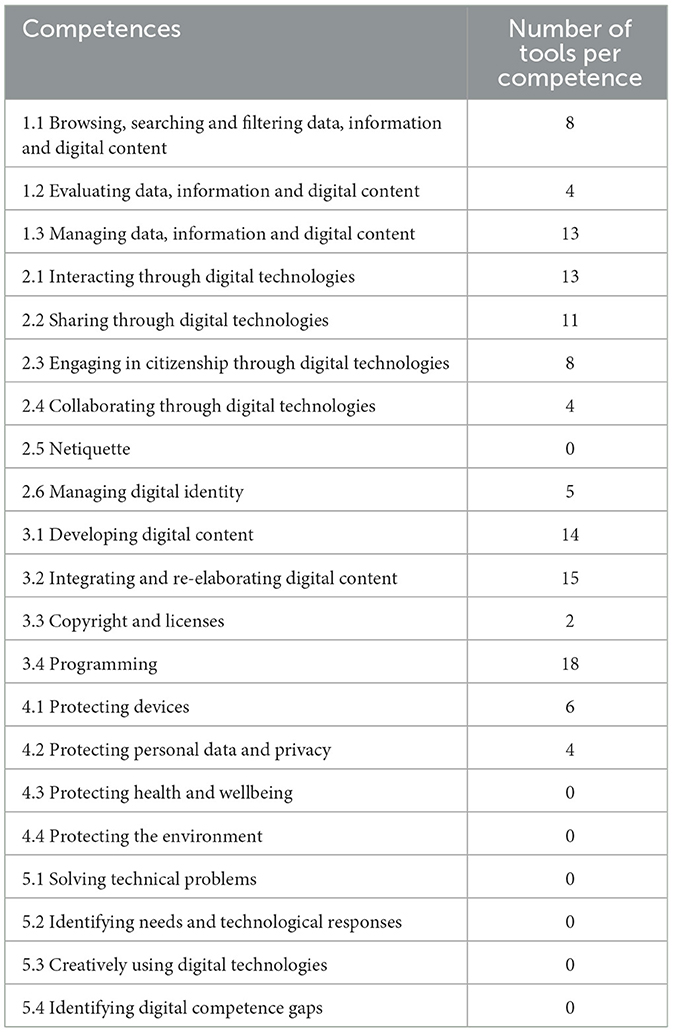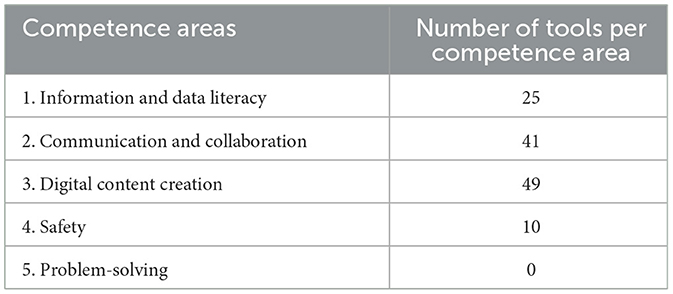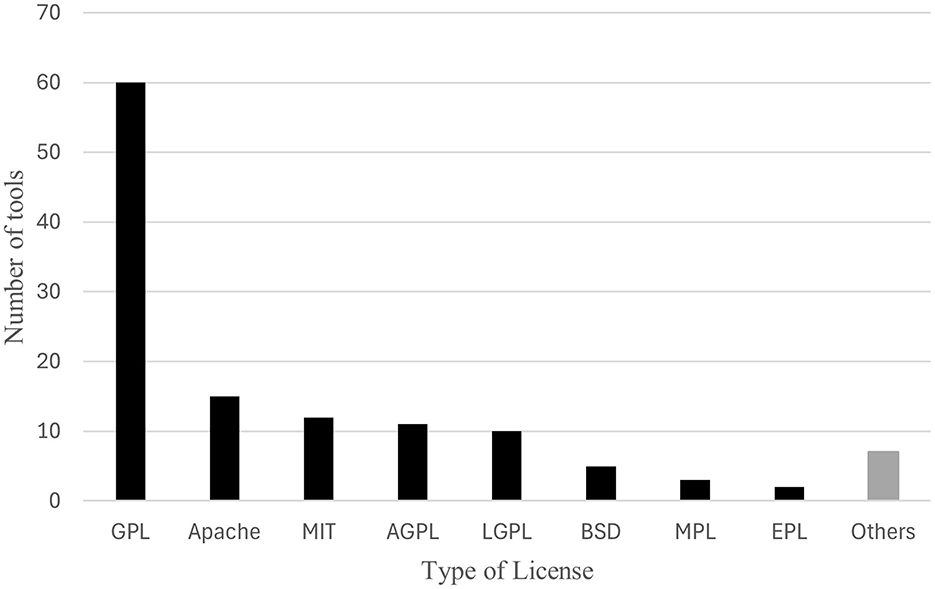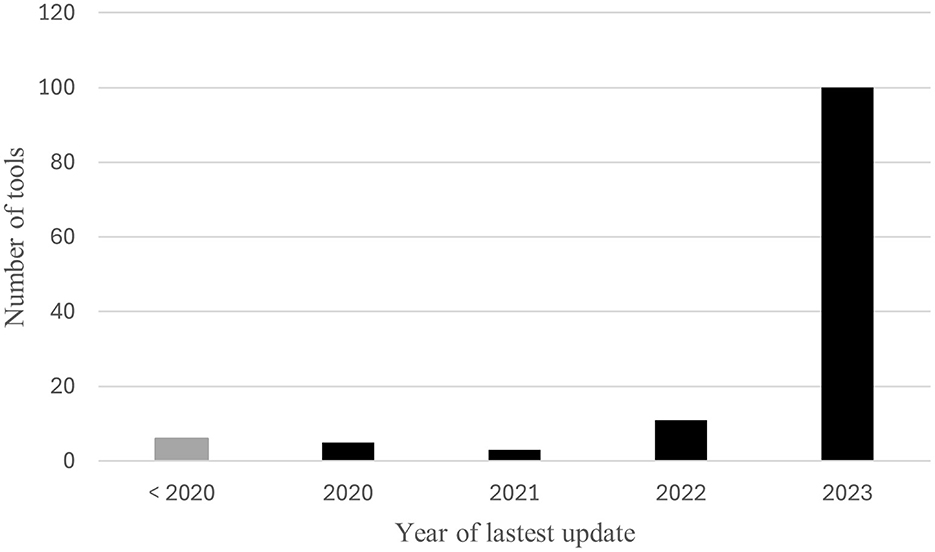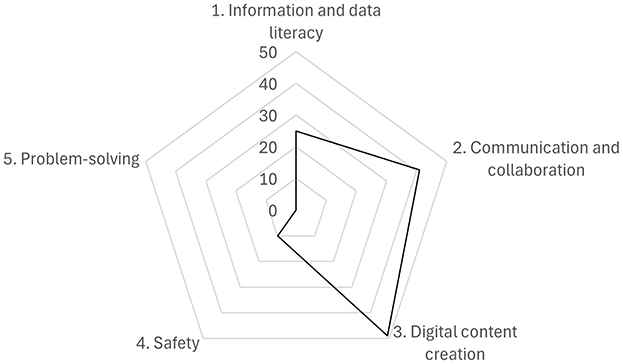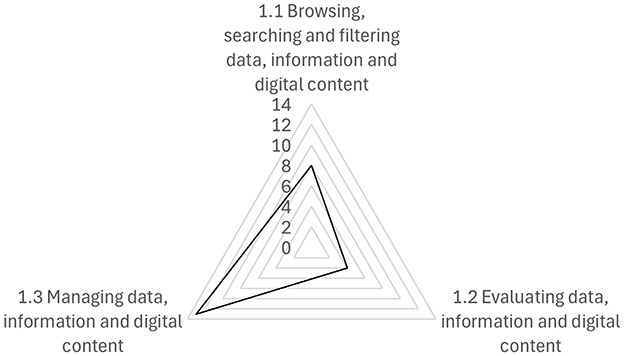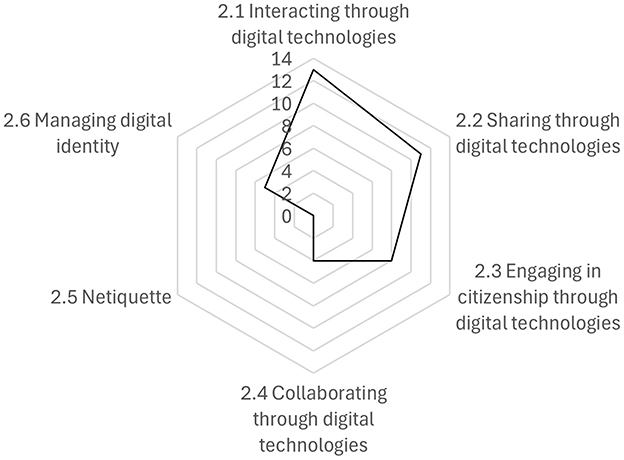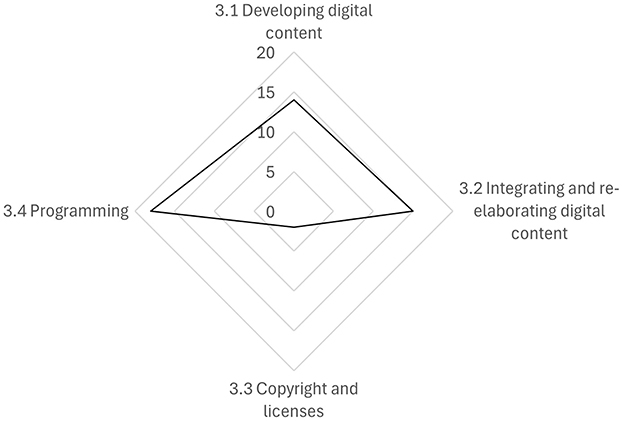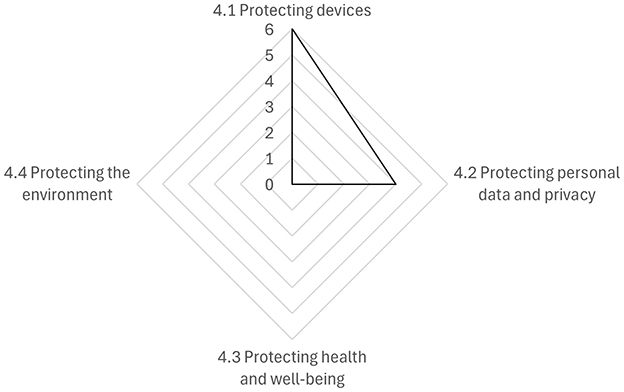- 1Universite de Pau et des Pays de l'Adour, E2S UPPA, LIUPPA, 2 allée du Parc Montaury, Anglet, France
- 2Department of Computer Engineering, Miguel Hernández University, Elche, Spain
Nowadays, the acquisition of digital competence is essential with the ongoing digital transformation. These digital competences can be gained with the help of various dedicated tools in a direct or indirect way. In this paper, we map open-source tools with the five competence areas defined by the Digital Competence Framework (DigComp) to facilitate the development of digital skills among citizens and resources for enhancing digital competence. By proposing quantitative and qualitative studies, the paper categorizes tools based on competences and contributes to the identification of areas where tools may be lacking. Furthermore, this research aims to bridge the gap between digital competence frameworks and available open-source tools. Results show a lack in open-source tools that help citizens to gain different skills, in particular the ones related to digital safety and digital problem-solving. In addition, the study highlights the need for the development of open-source tools that target specifically toward lacking digital skills among citizens.
1 Introduction
The process of digitization undertaken in all aspects of society demands the acquisition of digital competence in order not to stay behind all those changes (Belmonte et al., 2020). Digital competence became a key concept when discussing the sort of skills and understanding needed in today's society (Ferrari et al., 2012). Digital competence includes multiple areas, such as information management, collaboration, communication and sharing, creation of content and knowledge, ethics and responsibility, evaluation and problem-solving, and technical operations (Cisneros-Barahona et al., 2023a).
It is important to remark the difference between digital competence and digital literacy, even though many times they are referred to together. Digital competence is referred to indicate the skills needed to get by in today's society, while digital literacy is related to integrating computer literacy along with information literacy and media literacy (Zhao et al., 2021).
Nowadays, all citizens are expected to keep up with all technological innovations to apply them in the teaching-learning activities (Cisneros-Barahona et al., 2023b). Digital competences are considered like indicators of the quality of education and advancement of the society, as it is related to “technical information on the use of digital technologies, formal and informal digital environments of information in screening, assessment and management, communication and collaboration, digital content creation, digital media, providing safety, and problem-solving, job, employment, community inclusion, learning about digital technology to achieve the goals of critical, creative thinking, and in a confident manner” (Çebi and Reisoǧlu, 2020).
Likewise, the use of digital technologies does not only compress the necessary technical skills, but also the confident use in daily life and the critical assessments, along with the participation in the digital culture (Ilomäki et al., 2016). However, while digital competence allows us to take advantage of digital technologies, it is to be noted, that it is necessary to also deal with their disadvantages (Napal-Fraile et al., 2018).
In other words, digital competence is represented by a set of skills, knowledge and attitudes with a critical role in technology integration, which is considered as a requirement to achieve a quality education environment (Çebi et al., 2022). On one hand, citizens need to reach a certain level of knowledge in the digital domain. On the other hand, various digital software tools can serve as resources for citizens to enhance their knowledge and skills in this domain.
A software is defined by a set of executable code and instructions that controls a computer to accomplish a certain functionality. There are many business models of software for developing any application in computers. The main ones being: Freeware, Shareware, Trialware, Proprietary, Public Domain Software and Open Source (Pankaja and Raj, 2013). This study focuses on Open Source software defined by a software with source code that anyone can inspect, modify, and enhance (OpenSource.com, n.d.).
The European open source software strategy 2020–2023 promotes the sharing and reuse of software solutions, knowledge and expertise, in particular open source solutions, to deliver better services that benefit society and lower costs to that society (Open Source Software Strategy, 2020). In addition, more than 80% of the software code in use in modern applications uses open source code (Open Source Software Statistics, 2024). However, a primary problem in disseminating digital knowledge to citizens lies in the absence of a mapping between the targeted knowledge and the software/tools available in open source for acquiring it across the six levels of cognitive learning according to Bloom's Taxonomy (remember, understand, apply, analyze, evaluate, and create) (Bloom, 1956).
The growing use of Information and Communication Technologies (ICT) and the power of the Internet have fostered the emergence of a new generation of learners, for whom technology is an integral part of their lives, and therefore of the way they learn. To meet the specific needs of these new learner profiles effectively, teachers need to adopt significant digital transformations on an ongoing basis, revolutionizing the way they teach. Nowadays, teachers not only need to be able to use technology, they also need to develop digital skills that foster a better alliance of technology and pedagogy to better meet the expectations of learners with different profiles and backgrounds (Sanders and George, 2017). In all the frameworks available, the assessment of a teacher's digital competence is based on 3 levels: exploration, adaptation and leadership.
Our proposal is to classify the pieces of software held on the Interministerial Free Software Catalog (SILL), which is the reference catalog of free software recommended by DINUM (Direction Interministérielle du NUMérique) for the French administration [SILL (Socle Interministériel des Logiciels Libres), n.d.]. For this purpose, we created a mapping matrix where we collected the following data for each of those pieces of software.
Once the mapping matrix has been done, different spider web diagrams have been carried out in order to identify the different tools with their corresponding competence areas and competences. Therefore, the spider web diagrams have been analyzed to spot which competence areas and competences have a shortage of free software tools. This way, attention has been given to the points where such tools are lacking in order for developers to encourage new releases aimed at those missing tools.
The primary target audience is the general public, and the purpose is to map the most commonly used open source software tools within the SILL repository to digital competences, which will allow us to draw conclusions about the shortage or the lack of tools in certain areas. However, perhaps the most interested field in this research may be the education field, and the reason is twofold. On the one hand, the outcome of this mapping may help identify open-source tools that support teachers in developing their own digital competence. On the other hand, the results of this mapping may help identify tools that enable teachers to foster students' digital competence.
Sticking to the European Union, the former is addressed by the DigCompEdu framework, whereas the latter is addressed by the DigComp framework. Actually, Area 6 in the DigCompEdu framework is called Facilitating Learner's Digital Competence, and it could be seen as the point of convergence between both approaches, as it talks about the role of teachers when it comes to supporting the development of students' digital competence, according to the dimensions established in the DigComp framework.
Furthermore, it should be noted that this mapping is limited to the SILL database. This point is a limitation of this study, as the SILL database is widely used in France because it provides recommended tools to work with the French administration, even though its use outside France is not popular. Hence, this study may be extended in the future by considering other open source software databases within other European countries, or in the whole European Union, or even around the world.
2 Related work
To start with, the first subsection presents an outline of the most well-known digital competence frameworks. After that, the second subsection carries out a literature review related to mapping digital competences to tools.
2.1 Digital competence frameworks
A digital competence framework can be seen as a model used to define and assess the way individuals effectively use digital technologies. Different instances have been designed around the world, where some of them are currently in force in some countries, whilst some others are just recommendations at this point.
2.1.1 UNESCO ICT competency framework for teachers
The UNESCO ICT competency framework was designed for teachers in order to guide teacher training for effectively using digital technologies. As UNESCO is a global organization, there is no country of origin and this proposal is intended to national contexts. This framework includes 18 competences corresponding to the 6 aspects of a teacher's professional activity, namely, understanding ICT policies in education, curricula and assessment, pedagogy, application of digital skills, organization and administration, and professional training of teachers.
It also focuses on the use of ICT by teachers for pedagogical purposes, based on 3 levels: knowledge acquisition, knowledge enhancement and knowledge creation, on the assumption that teachers have already acquired basic skills in the use of ICT in their professional practice (UNESCO Digital Library, United Nations Educational, Scientific and Cultural Organization, n.d.). The framework analyzed corresponds to version 3, released in 2018. Supplementary Table 1 summarizes the key points.
2.1.2 Common Spanish Framework of Digital Competence for Teachers
The Common Framework of Digital Competence for Teachers was designed as a generic digital competence model for teachers. The country of origin is Spain and it has been in force since 2012, even though it got updated some times. It is a model based on the 5 competence domains of DigComp, namely, information and data literacy, communication and collaboration, digital content creation, security, and problem-solving. Furthermore, those 5 competence domains, also known as competence areas or macro competences, are subdivided into 21 competences, also known as micro competences (Spanish Framework, 2022).
Nonetheless, it should be noted that this framework is primarily an adaptation of DigCompEdu, which is not the same as DigComp. Actually, DigComp aims at increasing digital skills in general citizens, whereas DigCompEdu aims at rising digital skills in just teachers. In fact, the assessment of a teacher's digital competence in this framework is based on the 6 levels used in DigCompEdu, starting with the basic level (A1) and ending with the advanced level (C2). Supplementary Table 2 displays the crucial points.
2.1.3 British Framework of Digital Teaching
The British Framework of Digital Teaching was designed in order to improve the understanding of teachers when it comes to enhance their professional development. The country of origin is the United Kingdom and it has been in force since 2019. In other words, it was created to promote the use of digital technologies by teachers to improve their pedagogical and professional practices (Pérez-Sanagustín et al., 2022). The framework is composed of 7 areas of competence, described in Supplementary Table 3. Supplementary Table 3 exhibits the main points.
2.1.4 Holistic framework for teaching competence for a digital world (DT framework)
The DT framework was developed by some researchers after a process of literature review, along with grounded theory. Its focus is to provide teacher competence for a digital world, although the focus is not only set in technology, but also in other fields like pedagogy. There is no country of origin, as it was created by a multinational research team, and it is just a proposal. This framework characterizes the digital competence of a teacher with six elements from a systemic perspective. Those items are organized into three dimensions, such that pedagogical practices, professional learning environments, and social commitment. Supplementary Table 4 displays those six elements (Castañeda et al., 2021).
2.1.5 Australian framework for generative AI in schools
On the other hand, artificial intelligence (AI) is quickly catching on in all fields, and teaching is not an exception. AI could bring the teaching-learning process a step forward, because of all the advantages it may provide. However, its tremendous potential could also lead to dangerous situations, which could be corrected by the design of specific frameworks.
In this sense, Australia recently released a framework for generative IA in schools (Australian Framework, 2023), which is intended for students, teachers, parents and carers. Its goals are geared to enhance educational outcomes and ethical practices, as well as to facilitate equity and inclusion. Those goals are the basis of the following six principles and twenty-five guiding statements, shown in Supplementary Table 5.
2.1.6 DigCompEdu framework
The DigComp framework was designed by the Joint Research Centre, who was acting on behalf of the European Commission. It got published in 2017 and its target is the alignment of the European educational policies to this framework. It was conceived for educators in order to develop their digital competences and it is not in force, although it is widely used in the countries belonging to the European Union (Kotorov, 2023).
This framework present six competence areas, distributed into educator's professional competences, educator's pedagogic competences, and learner's competences. Additionally, 22 competences are organized into those competence areas, where different connections are established among some of those competences, as shown in Supplementary Figure 1. Moreover, each competence area represents the competences expected for teachers so as to promote effective, inclusive, and innovative learning strategies by means of using digital tools (Redecker, 2017).
2.1.7 DigComp framework
The DigComp framework was designed by the Joint Research Centre, who was acting on behalf of the European Commission. It got started in 2010 and its current version is 2.2. It was thought for general citizens and it is not in force, even though it is widely used throughout the European Union. According to the Council Recommendation on Key Competences for Long-Life Learning of the European Union, digital competence (DigComp) involves “confident, critical and responsible use of, and engagement with, digital technologies for learning, at work, and for participation in society. It is defined as a combination of knowledge, skills and attitudes” (Vuorikari et al., 2022).
From that definition, the DigComp framework was created to group the key aspects of digital competence in five different areas, which form part of Dimension 1 (Solís et al., 2023). Such areas are identified in Supplementary Figure 2, which involve information and data literacy, communication and collaboration, digital content creation, safety and problem-solving.
Furthermore, those five areas may be subdivided into twenty-one competences, which form Dimension 2, whereas Dimensions 1 and 2 altogether form the conceptual reference model. Additionally, more dimensions could be added, such as Dimension 3 is related to proficiency levels, Dimension 4 portrays examples related to knowledge, skills and attitudes, whilst Dimension 5 talks about use cases (Silva-Quiroz and Ríoseco-País, 2025). Putting all together, the latest release of the consolidated framework was done in 2022, and it is referred to as DigComp 2.2.
Although DigComp is the most well-known competence framework proposed by the European Commission, other frameworks have also been released, such as EntreComp (Bacigalupo et al., 2016), LifeComp (Sala et al., 2020), GreenComp (Bianchi et al., 2022), or financial competence for adults (OECD, 2022), which are focused on key competences related to entrepreneurship, personal-social life, sustainability, and personal finance, respectively. Anyway, DigComp could be defined as the European Digital Competence Framework for citizens, which is divided into competence areas, and further divided into competences.
The frameworks proposed above are some of the most widely spread across the world when it comes to digital competence frameworks, although there are others around, such as the one proposed by ISTE, or the one assumed in Colombia, or even the one accepted in Chile (Cabero-Almenara et al., 2020). Nonetheless, they all share some common traits, such as managing digital information, communication in social media and media narratives, digital content creation with multimodal languages, digital identity and reputation development, critical thinking and responsibility, and problem-solving (Pérez-Escoda et al., 2019).
DigComp stands out as the most complete framework for digital competences. On the one hand, it covers a wide range of different contexts since it covers a wide range of competencies, from fundamental digital skills to more complex ones like creating digital content and problem-solving. On the other hand, DigComp has gained international recognition and validations by organizations such as the European Commission. This recognition serves as a standard benchmark for digital competence assessment and development across various sectors and countries. Additionally, DigComp is also geared to help achieve key competences for lifelong learning (European Commission: Directorate-General for Education, Youth, Sport and Culture, 2019).
2.2 Mapping digital competences to tools
The literature devoted to mapping digital competences to tools could be divided into different categories, such as those related to concepts of digital competences, the ones about acquiring digital competences, others about digital competences for educators, and a bunch of them related to the mapping itself.
To start with, Directorate-General for Employment, Social Affairs and Inclusion of the European Commission identify digital competence as the most transferable competence for lifelong learning among a bunch of eight key competences (European Commission: Directorate-General for Employment, Social Affairs and Inclusion, 2011). Those competences are communication in the mother tongue, communication in foreign languages, mathematical competence and basic competences in science and technology, digital competence, learning to learn, soft competences including interpersonal, intercultural, social competences and civic competences, entrepreneurship, and cultural expression (Şahin et al., 2010).
In this context, different studies reached the conclusion that the DigComp digital competence framework is adequate as a generic layout for professional practice, such as the one undertaken by Evangelinos and Holley (2015). In this study, fourteen interview themes were carried out related to competence areas and competences. Specifically, the themes associated with the information competence were technology use in education and information management. Those related with communication were communication and collaboration, social networks and media, and communities of practice. Those associated with content creation were legal and ethical aspects, and content authoring and remixing. Those related to safety were balanced use of technology, security and privacy, and technology and the environment. And those associated with problem solving were learning skills and support, manuals and instructions, hardware and software, and learning about new technologies.
The responses of all those interviews were mapped with the items described in the DigComp framework. The outcome of this study displayed that learners tend to combine work usage with social usage, thus misdiagnosing their actual competence. Moreover, educators were cautious the amount of work-based data getting into their personal devices, whilst administrative staff applied for a more structured approach on workloads.
Colás-Bravo et al. stated that the DigComp framework helps teachers to train students in the use of digital technologies, considering a critical and responsible fashion, such as those related to the different areas conforming to the DigComp framework. Those areas are information, communication, content generation, wellbeing and problem-solving (Colás-Bravo et al., 2019).
Arif et al. (2023) proposed a mapping study on the use of digital methods and tools by teachers to develop their digital skills. This study uses descriptive statistics techniques to analyze quantitative data collected through a survey. It provides information and recommendations on the types of devices, digital tools and ways in which teachers integrate and use digital technology for pedagogical purposes. The elements of this mapping are described in Supplementary Table 6.
This research provides information on the types of digital devices and tools, and how these technologies can be used in relation to the digital skills needed by the teacher. However, it does not provide explicit information on the identification of tools or platforms in relation to the application of the teacher's digital skills. Moreover, they do not stick to any of the standard competence frameworks shown above.
On the other hand, different approaches have been taken in the literature about skills involved in digital literacy. For instance, Kumpulainen et al. divide digital literacy into three categories, such as operational, cultural and critical, where the first one is based on using digital tools and solving technical problems with them, the second one is based on communication and collaboration through digital tools, and the third one is about making judgements about digital tools related to security and trust (Kumpulainen et al., 2020).
Pérez-Escoda et al. classify digital competence and smart learning into five different areas, such as information and data literacy, which is related to the use of digital information, communication and collaboration, which relates to the ability to interact through digital tools, digital content creation, which is referred to the creation of such a content, security, which is related to privacy, and problem-solving, which is referred to innovation and identification of issues (Pérez-Escoda et al., 2021). Similarly, López-Belmonte et al. distribute digital competence into three areas, such as social, focused on interaction with others, digital skills, devoted to the ability to use tools, and active methodologies, dedicated to their implementation in the lessons (López-Belmonte et al., 2021).
Furthermore, Martín-Párraga et al. talk about the growing importance of didactic digital competences for teachers through meaningful and innovative pedagogical practices, which are organized in three big classes, such as professional, and pedagogical (Martín-Párraga et al., 2022). In any case, the ability on each area could be measured through quantitative instruments, such as surveys, where the quality of the measures obtained are given according to the fulfillment degree of two psychometric properties, namely validity and reliability (Saltos-Rivas et al., 2021).
However, tools are not always available for citizens. Therefore, open-source tools are the solution for every user to have access to technologies that help them reach higher levels of digital competences. In this sense, the Socle Interministériel des Logiciels Libres (SILL), also known as Interministerial Free Software Catalog of the French Republic, is the reference catalog of free software recommended for the French administration [SILL (Socle Interministériel des Logiciels Libres), n.d.]. Its main role is supporting government agencies in enhancing their use of open-source software and assisting their efforts in publishing source code. It includes more than 400 open source software used by more than 70 organizations in France [Open Source Observatory and Repository (OSOR), n.d.]. Therefore, we chose to use this catalog as our search database to find open source solutions recommended in the European Union.
3 Materials and methods
To start with, the research process focused on the official website dedicated to open source software to be used among the French ministries. This website is called “Socle Interministériel des Logiciels Libres”, whose acronym is SILL. This is a common reference among French public institutions when it comes to open source software, which is also widely used among individuals and private companies. The repository was composed of over four hundred pieces of open source software by the end of 2023, where some information about each individual piece was provided. However, not all pieces of software had the same information available, as some details were not available in some pieces.
Therefore, the motivation of this work was to compile the most well-known pieces of open source software within the SILL repository in order to map each of them to the most appropriate competence within the DigComp framework. This way, it would be possible to detect whether some competences are short of open source software tools, as well as it would be possible to spot whether some other competences have no open source software tools at all. This is actually the main focus of this research.
The inclusion criteria were determined in two stages. In the first one, all pieces of software were classified into one of the 21 competences available in the DigComp framework. In the second one, and focusing just on the competences having many pieces of software, those pieces were reduced in order to only include the most popular pieces, thus discarding other pieces whose use could be residual. In this context, it is to be noted that the main goal exposed above would not be altered in any way, as the competences where the pieces of software associated were just a few or none at all would still be spotted, whilst the rest of the competences would not be overrepresented by relatively unknown pieces.
A mapping matrix was carried out, such that for each piece of open source software it was selected the most relevant competence associated to it. In other words, each piece was assigned to only one competence according to its most relevant use. It is to be noted that there was a small number of pieces addressing more than one competence, even though in all cases those competences were overrepresented. On the other hand, the data extraction and analysis process was made by hand, going one by one through all the pieces of software within the SILL repository. Hence, for each entry, the authors collected all the relevant metadata about it, followed by a discussion about the main competence addressed in each case. Eventually, a further filtering was carried out so as to choose the most popular pieces for each overrepresented competence, obtaining around a hundred pieces of software, which were used to graphically describe the findings of this study.
Delving into the process for including or excluding tools out of the SILL catalog, it is to be noted that it was manually done by the three authors of this paper. It happens that two of them are based in France, thus they are used to check the catalog on a regular basis for different tasks related to their work, whereas another one was based in Spain, thus he had no previous contact with this catalog. This fact minimized the possible bias when it comes to classifying the different software tools, as not all authors had the same background about the use of those tools.
The classification process was carried out in two stages, where the first one was more qualitative, and the second one was more quantitative. In fact, in the first stage, all authors went through all tools and discussed the most appropriate competence addressed by each one. There were more than four hundred instances and in each case the authors voted for the most appropriate competence addressed after a discussion among them.
Then, in the second stage, all authors went through the instances grouped into each competence and checked their numbers of users and their references in the catalog, along with the degree of knowledge from the authors' point of view of each instance. After that, the authors decided not to filter the instances within the underrepresented competences, thus being those with few instances. However, the competences with many instances were filtered by only including the most relevant instances according to the criteria listed above, namely the quantitative data provided by the catalog about the number of users and references, and the qualitative data provided by the users about their knowledge about it. At the end of this process, a list of 125 instances was selected.
Additionally, Table 1 displays the operationalization of variables, where the 21 competences included in the DigComp framework are displayed, grouped by five competence areas.
Focusing on the mapping matrix employed to carry out the classification of software tools, the following data were collected for each of those pieces of software.
– competence area, which identifies the key area where each competence belongs to (Dimension 1, according to DigComp's structure)
– competence, which is related to the intended purpose of each tool (Dimension 2, according to DigComp's structure)
– tool name, with the commercial name of the tool
– license, with the type of license of use applied to each tool
– description, with a short explanation of the aim of each tool
– launch year, with the year when the tool was first released
– last release year, with the month and year of the last version of the tool
– category or comments, where a quick comment is made on each tool
On the other hand, Table 2 exhibits the criteria followed in order to classify the different pieces of open source software collected out of the SILL repository. The criteria established during the classification stage were related to the main use of each software tool, even though in some cases some tools might have more than one use.
Regarding competence 1.1, dedicated to tools for accessing digital content, the categories involved were accessibility, data engine, search engine, and web browser. With respect to competence 1.2, devoted to tools for evaluating digital content, the categories concerned were form, and survey. With regards to competence 1.3, committed to tools for managing digital content, the categories affected were cloud management, database management, library management, mailing list management, project management, task management, and video management.
With respect to competence 2.1, dedicated to tools for interacting with digital content, the categories involved were hypervisor, operating system, private branch exchange, and software container. With regards to competence 2.2, devoted to tools for sharing digital content, the categories concerned were eLearning, email server, file sharing, videconferencing server, and web server. Regarding competence 2.3, committed to engaging through digital content, the categories affected were email client, forum, and instant messaging.
With respect to competence 2.4, dedicated to tools for collaborating through digital content, the categories involved were collaborative development, and version control. Regarding competence 2.5, devoted to tools for netiquette, the only category concerned was netiquette. With regards to competence 2.6, committed to identity management, the only category affected was identity management.
Regarding competence 3.1, dedicated to tools for developing digital content, the categories involved were blog, content management system (CMS), documentation, graphic design, and wiki. With regards to competence 3.2, devoted to tools for integrating and re-elaborating digital content, the categories concerned were data visualization, file compression, office suite, PDF manager, PDF viewer, screenshot, terminal emulator, and text editor. With respect to competence 3.3, committed to tools for dealing with copyright and licenses, the only category selected was reference manager. Regarding competence 3.4, dedicated to tools for programming, the categories involved were automation platform, integrated development environment (IDE), programming language, runtime environment, and testing & CI/CD.
With regards to competence 4.1, devoted to tools for protecting devices, the categories involved were antivirus, block tracker, disk encryption, hardening, secure docker image, and secure endpoint. With respect to competence 4.2, committed to tools for protecting personal data and privacy, the categories concerned were data anonymization, password manager, and storage security. Regarding competence 4.3, committed to protecting health and wellbeing, the only category concern was health & well-being. With respect to competence 4.4, dedicated to tools for protecting the environment, the only category affected was environment.
With regards to competence 5.1, devoted to tools for solving technical problems, the only category involved was solving issues. Regarding competence 5.2, committed to tools for identifying needs and technological resources, the only category affected was needs & resources. With respect to competence 5.3, dedicated to tools for creatively using digital technologies, the only category concerned was creative uses. Regarding competence 5.4, devoted to tools for identifying digital competence gaps, the only category involved was competence gaps.
The current version of DigComp is 2.2, which was released in March 2022 (Data Media Group, 2022). Later in that year, namely in November 2022, Open AI released the prototype of ChatGPT, a chatbot tool which changed the paradigm related to the use of Artificial Intelligence by the general public (Haleem et al., 2022). Besides, it happens that year 2023 is generally considered as the generative AI's breakout year (McKinsey & Company, 2023), as use of AI was only located in specific environments.
On the other hand, DigComp 2.2 incorporates aspects of AI, although in this study the AI tools have not being included within the relevant competences of DigComp 2.2 because the deadline considered in this study is the end of 2023. In fact, many of the common AI tools used nowadays were released during that year, hence those AI tools were just at their starting point. Hence, we decided to dedicate a separate section exclusively to generative AI tools in order to highlight its growing importance.
Furthermore, consultations for the development of the next version of DigComp, namely DigComp 3.0, have already started in 2025. Maybe the greatest challenge is to consider the quick development and use related to generative AI. The first drafts take AI as integral to digital competence, thus being interrelated with all competence areas, as exhibited in Supplementary Figure 3. Moreover, those drafts consider 4 components related to AI competence, which are know and understand AI, use and apply AI, evaluate and create AI, along with ethics and societal implications of AI (AI Pioneers, 2025).
4 Results
Computer tools play an essential role in developing digital competence by providing a means to effectively use and understand digital technologies. They provide learners with access to many resources and functionalities, enabling individuals to master essential digital competences such as coding, data analysis, and digital communication. Additionally, computer tools contribute to a dynamic learning environment, where individuals can explore, create, and innovate. Hence, computer tools are becoming an essential part of the digitalized society, as they make possible the interaction with ICT, which are key in the labor market and in lifelong learning.
Therefore, in this paper, we mapped around a hundred of the most commonly used open source tools available on the SILL repository in 2023 to the digital competences from DigComp. Our goal is to identify the available tools that help individuals to gain a specific competence, while identifying the lack of tools related to other competences in order to guide developers toward the creation of specific open source tools that respond to these needs (Ríoseco-País et al., 2023). In the following subsections, we align each of the five main knowledge areas defined by DigComp with tools that positively contribute to achieve each competence.
4.1 Information and data literacy
The competence area “1. Information and data literacy” is divided into three competences. The first competence is called “1.1 Browsing, searching and filtering data, information and digital content”, and the available tools found have been categorized in Table 3.
The second competence is called “1.2 Evaluating data, information and digital content”, and the available tools found have been categorized in Table 4.
The third competence is called “1.3 Managing data, information and digital content”, and the available tools found have been categorized in Table 5.
4.2 Communication and collaboration
The competence area “2. Communication and collaboration” is divided into six competences. The first competence is called “2.1 Interacting through digital technologies”, and the available tools found have been categorized in Table 6.
The second competence is called “2.2 Sharing through digital technologies”, and the available tools found have been categorized in Table 7.
The third competence is called “2.3 Engaging in citizenship through digital technologies”, and the available tools found have been categorized in Table 8.
The fourth competence is called “2.4 Collaborating through digital technologies”, and the available tools found have been categorized in Table 9.
The fifth competence, “2.5 Netiquette”, which relates about being aware of behavioral norms and know-how during the interactions in digital environments, has no associated tools in the database of open source tools we used. However, there is an open source network monitor solution called NetIQuette v1.0, released in 2019, although it is only available for macOS.
The sixth competence is called “2.6 Managing digital identity”, and the available tools found have been categorized in Table 10.
4.3 Digital content creation
The competence area “3. Digital content creation” is divided into four competences. The first competence is called “3.1 Developing digital content”, and the available tools found have been categorized in Table 11.
The second competence is called “3.2 Integrating and re-elaborating digital content”, and the available tools found have been exhibited in Table 12.
The main available tools used for copyright and licenses (competence 3.3) can be categorized into 1 category : bibliographic management tools. Those tools have been shown in Table 13.
The main available tools used for programming (competence 3.4) can be categorized into 2 categories: programming languages and Integrated Development Environment (IDE). Those tools have been shown in Table 14.
4.4 Safety
The competence area “4. Safety” is divided into four competences. The first competence is called “4.1 Protecting devices”, and the available tools found for this point have been categorized in Table 15.
The second competence is called “4.2 Protecting personal data and privacy”, and the available tools found have been categorized in Table 16.
The third competence, “4.3 Protecting health and wellbeing”, which enables people to protect themselves and others from possible dangers when using digital technologies, has no associated tools in the database of open source tools we used. As for the fourth competence, “4.4 Protect the environment”, which enables people to be aware of the environmental impact of digital technologies and their use, no available tools were found.
4.5 Problem-Solving
The competence area “5. Problem-solving” is divided into four competences. The first two competences concern “5.1 Technical problem-solving” and “5.2 Identifying needs and technological responses”. They provide knowledge, skills, and attitudes related to troubleshooting and solving more complex problems when using digital devices and environments, as well as assessing needs, identifying, choosing and using digital tools. For example, knowing the main functions of the most common digital devices, or knowing how to find solutions on the Internet when faced with a technical problem. However, we have not found any specialized tools that can be associated with these competences from the used tools within the open source database.
The same issue has been found for the third competence, which is entitled “5.3 Creatively using digital technology”. It consists of knowledge creation and innovation in processes and products, as well as individual and collective engagement in cognitive processing for the comprehension and problem-solving of conceptual problems and challenging situations in digital environments. For example, knowing that Internet of Things (IoT) technology applications have the potential to be used in many different sectors or identifying online platforms that can be used to design, developing and testing IoT technologies and mobile applications would fit in this point. Nonetheless, no specialized tools have been found within the database.
Likewise for the fourth competence, which is branded “5.4 Identifying digital competence gaps”. It consists of improving and updating one's own digital competence in line with digital evolution, although no tools within the database could be associated with it.
5 Discussion
In this section, the results shown above are discussed in order to spot the competences with a shortage of tools available.
5.1 Mapping open source tools to DigComp competences
In order to better visualize the results of this study, Table 17 shows a quantitative representation of the number of open source tools that helps citizens to gain each of the competences defined in DigComp.
Table 18 shows a quantitative representation of the number of open source tools that help citizens gain each of the competence areas defined in DigComp.
Additionally, the SILL database contains heterogeneous open source tools with various utilities based on a wide range of open source licenses, as shown in Figure 1. However, around half of the tools studied have a GPL license, namely GNU General Public License, which is the one providing free software, whereas the rest of the tools show more restrictive features within the open source range.
Furthermore, each mapped tool has been categorized based on the year of release of its latest version. Our findings indicate that these tools are generally up-to-date, as most of them had their latest released version in the last year considered in this study, namely 2023, as seen in Figure 2. This shows that these tools are modern and compatible, making them suitable for citizens to acquire appropriate levels of competence.
On the other hand, the main point to discuss in this study related to the software tools found in the SILL catalog is that the number of tools classified in each competence is not equally distributed, as seen in Tables 17, 18. This means that there are some competence areas having many tools available, whereas there are some others that have just a few, or even none. This is better appreciated through a series of spider graphs, which may help identify the lack of tools available for certain competences and competence areas. In this sense, Figure 3 depicts a spider graph with the amount of tools available per each competence area.
Beginning with competence area 1 (information and data literacy), as seen in Figure 4, competence 1.1 has twice as many tools available compared to competence 1.2, whereas competence 1.3 has more than the rest altogether. Therefore, we could say that there are plenty of software applications for information and data literacy, although many of them focus on managing data, information and digital content. This way, it would be necessary to develop more open source applications related to evaluating data, information, and digital content, whilst it would be interesting to develop more options for browsing, searching and filtering information and digital content.
Moving to competence area 2 (communication and collaboration), as seen in Figure 5, competences 2.1 and 2.2 have a similar quantity of tools available, as both are two-digit figures. Besides, competence 2.3 have a lower amount of tools, while competences 2.4 and 2.6 show an even lower amount of tools available. On the other hand, competence 2.5 has no available tools. Therefore, we could say that there is an unbalanced distribution of software applications for communication and collaboration. This way, it would be required to develop some open source applications related to netiquette, while it would be necessary to develop more options for collaboration through digital technologies and managing digital identity. Moreover, it would be interesting to develop extra options for engaging through digital technologies. On the other hand, there is a wide range of options for interacting through digital technologies and sharing through digital technologies.
Going into competence area 3 (digital content creation), as seen in Figure 6, competences 3.1 and 3.2 have a similar number of solutions available, which are both two-digit fugres. Likewise, competence 3.4 also has many options available, whose number is even higher than those related to the other competences. Hence, it can be said that there are enough open source software tools to develop digital content, which also happens to the options for integrating and re-elaborating digital content, and also for the solutions for programming. However, there is a shortage related to competence 3.3, which is dedicated to copyright and licensing, where only two applications have been found. Therefore, it would be necessary to develop solutions referred to this point.
Sticking to competence area 4 (safety), as seen in Figure 7, competence 4.1 has some open source software tools available, whereas competence 4.2 has a slightly lower number, while competences 4.3 and 4.4 have none. Therefore, it would be required to develop software solutions related to protecting health and wellbeing, as well as protecting the environment. Moreover, it would be necessary to design more applications related to protecting personal data and privacy, whereas it would be interesting to design more solutions referred to protecting devices.
Finally, focusing on competence area 5 (problem-solving), it happens that no specific application has been found related to any of its competences, which are solving technical problems, identifying needs and technological responses, creatively using digital technologies and identifying digital competence gaps. Therefore, it would be required to design software solutions centered on them.
It has to be reminded that there are software applications in the market targeting all competences, even those where we found no instances available. However, those solutions do not belong to open source software, and because of that, they are not suitable to be included into this study. Therefore, the conclusion of this study is to point out the areas where new open source solutions are needed, which are basically those with no instances available, along with those with few instances found.
In the case of competences with no instances found, it would be really convenient for developers to design this type of open source applications, as there are no open source alternatives available, which would fill in a need in the market. Supplementary Table 7 shows the competence areas and competences involved, with no instances available.
Focusing on competence area 5, there is no open source tools available whatsoever. However, for the competences 5.1 and 5.2, it is possible to access open online courses or tutorials, websites, platforms and collaborative forums where other users can help and share their experiences. Moreover, it is also possible for the competence 5.3 to learn and acquire this type of knowledge and skills through platforms with theoretical and practical resources, such as the free online platform Tinkercard produced by Autodesk (Tinkercard, n.d.).
For competence 5.4, there is a tool on the Europass platform that can be used to test digital skills to find out more about digital skills, discover the level and do what is needed to improve them (Europass, n.d.). Based on the results of the test, it is possible to receive suggestions for training courses to develop digital skills, with opportunities to explore learning paths that help understand the digital skills that need to be improved to reach a target goal.
On the other hand, in the case of competences with few instances found, it would be interesting for developers to design this kind of applications in order to provide more open source alternatives to the actual solutions available in the market. Supplementary Table 8 shows the competence areas and competences involved, with few instances available.
5.2 Digital competence in the age of generative artificial intelligence (AI)
Nowadays, the rapid development of new and emerging technologies based on generative Artificial Intelligence (AI) is fostering the emergence of new digital skills that mark a decisive step in our digital era (Chan, 2023). That is why version 2.2 of the DigComp Framework integrates this new paradigm into each macro-skills, along with micro-skills in order to encourage innovation and exploit the opportunities generated by AI.
However, in order to develop new personal and professional practices, it is necessary to map, measure and close digital skills gaps. To do this, we need to adopt a culture of innovation and continuous learning, with a curiosity to try out new technologies to develop skills. Supplementary Table 9 below provides a non-exhaustive list of generative AI tools available.
6 Conclusions
In this paper, we presented a mapping between the EU DigComp framework and open source tools from the SILL tools dataset made by the French republic and analyzed the results of our mapping in a quantitative and qualitative manner.
Furthermore, our research underscores the significance of open-source tools in the development of digital skills among citizens. By aligning these tools with the Digital Competence Framework (DigComp), we offer a structured approach toward enhancing digital competences through available open-source tools. Finally, we found that there is a lack of tools that contribute to different knowledge areas of the DigComp Framework, in particular for safety and problem-solving. Therefore, we encourage software developers to carry out open source designs in those areas.
Focusing on the lack of open source software tools spotted in this study related to some particular competences, it should be noted that it brings different types of impact in different user groups. In this sense, educators may have difficulties in order to organize their classes when those specific competences are to be worked into. On the other hand, students are likely not to acquire the necessary skills related to those specific competences due to the lack of practice.
A possible solution could be to adopt proprietary software tools to cover those competences, although this solution is often unaffordable from the point of view of public administrators due to the necessary amount of money to cover the license fees associated with those tools. Hence, the availability of open source software tools tackling each of those competences would fix the issue for all user groups.
Additionally, the results of this study suggest a series of implications for different stakeholders. First of all, developers should get involved in the design of open source tools aimed at those competences where there is a lack of instances, or otherwise, there is a shortage of instances available. Nonetheless, developers should also get involved in creating new tools and improving existing tools aimed at the rest of competences. Besides, educators should get familiar with the open source software tools needed for their courses, which involves informal training by themselves, as well as formal training through specific courses organized by their managers.
Moreover, policymakers should be aware of the shortage of tools for certain competences, which may allow them to work according to different paths. The first one could be to avoid those competences in the education policies. This may lead to a lack of abilities for students in such competences, which may produce undesired effects due to the inability in some areas. The second one could be to minimize those competences in the education policies. This may lead to have low-coverage in such competences, which may also lead students to undesired effects due to the shortage of skills in some areas. The third one could be to encourage developers to get the necessary open source tools ready as soon as possible in order to help students acquire an adequate level in all competences.
In future research, we plan on expanding the scope of our research by applying our mapping to additional open-source tools, particularly those available on platforms like GitHub. The inclusion of a broader range of open-source tools will contribute to a more comprehensive understanding of the applicability and effectiveness of our methodology.
In addition, we intend to further explore the potential of AI tools aimed at enhancing citizens' digital competences. Moreover, future research should focus on assessing citizens' proficiency levels in safety and problem-solving while exploring various methodologies to measure efficiently the level of knowledge of these competences.
Data availability statement
The original contributions presented in the study are included in the article/Supplementary material, further inquiries can be directed to the corresponding author.
Author contributions
HK: Conceptualization, Data curation, Formal analysis, Investigation, Methodology, Resources, Supervision, Validation, Visualization, Writing – original draft, Writing – review & editing. MG: Conceptualization, Data curation, Formal analysis, Investigation, Methodology, Resources, Supervision, Validation, Visualization, Writing – original draft, Writing – review & editing. PR: Conceptualization, Data curation, Formal analysis, Investigation, Methodology, Resources, Supervision, Validation, Visualization, Writing – original draft, Writing – review & editing.
Funding
The author(s) declare that no financial support was received for the research and/or publication of this article.
Conflict of interest
The authors declare that the research was conducted in the absence of any commercial or financial relationships that could be construed as a potential conflict of interest.
Generative AI statement
The author(s) declare that no Gen AI was used in the creation of this manuscript.
Publisher's note
All claims expressed in this article are solely those of the authors and do not necessarily represent those of their affiliated organizations, or those of the publisher, the editors and the reviewers. Any product that may be evaluated in this article, or claim that may be made by its manufacturer, is not guaranteed or endorsed by the publisher.
Supplementary material
The Supplementary Material for this article can be found online at: https://www.frontiersin.org/articles/10.3389/fcomp.2025.1552695/full#supplementary-material
References
AI Pioneers (2025). DigComp 3.0 Consultation. Available online at: https://aipioneers.org/digcomp-3-0-consultation/ (Accessed June 15, 2025).
Arif, M. Z., Nurdin, D., and Sururi, S. (2023). Mapping the use of digital learning tools and methods for increasing teachers' digital competence. Jurnal Pendidikan Glasser 7:226. doi: 10.32529/glasser.v7i2.2528
Australian Framework for Generative Artificial Intelligence (AI) in Schools. (2023). Department of Education, Australian Government. Available online at: https://www.education.gov.au/schooling/resources/australian-framework-generative-artificial-intelligence-ai-schools/ (Accessed December 27, 2024).
Bacigalupo, M., Kampylis, P., Punie, Y., and Van den Brande, G. (2016). EntreComp: The Entrepreneurship Competence Framework. Luxembourg: Publications Office of the European Union.
Belmonte, J. L., Sánchez, S. P., Cabrera, A. F., and Campoy, N. D. (2020). El nivel de competencia digital en profesionales de la educación: El caso de los educadores físicos espa noles. Zona Próxima 33, 146–164. doi: 10.14482/zp.33.371.334
Bianchi, G., Pisiotis, U., and Cabrera-Giráldez, M. (2022). GreenComp The European Sustainability Competence Framework. Luxembourg: Publications Office of the European Union, Luxembourg.
Bloom, B. S. (1956). Taxonomy of Educational Objectives: the Classification of Educational Goals. London: Longmans, Green & Co.
Cabero-Almenara, J., Romero-Tena, R., and Palacios-Rodríguez, A. (2020). Evaluation of teacher digital competence frameworks through expert judgement: the use of the expert competence coefficient. J. New Approch. Educ. Res. 9:275. doi: 10.7821/naer.2020.7.578
Casta neda, L., Esteve-Mon, F. M., Adell, J., and Prestridge, S. (2021). International insights about a holistic model of teaching competence for a digital era: the digital teacher framework reviewed. Eur. J. Teach. Educ. 45, 493–512. doi: 10.1080/02619768.2021.1991304
Çebi, A., Özdemir, T. B., Reisoǧlu, İ., and Çolak, C. (2022). From digital competences to technology integration: Re-formation of pre-service teachers' knowledge and understanding. Int. J. Educ. Res. 113:101965. doi: 10.1016/j.ijer.2022.101965
Çebi, A., and Reisoǧlu, I. (2020). Digital competence: a study from the perspective of pre-service teachers in Turkey. J. New Approch. Educ. Res. 9, 294–308. doi: 10.7821/naer.2020.7.583
Chan, C. K. C. (2023). A comprehensive AI policy education framework for university teaching and learning. Int. J. Educ. Technol. Higher Educ. 20:38. doi: 10.1186/s41239-023-00408-3
Cisneros-Barahona, A., Marqués-Molías, L., Samaniego-Erazo, N., Uvidia-Fassler, M. I., Castro-Ortiz, W., and Villa-Yánez, H. (2023a). Competencia digital, profesorado y educación superior. Human Rev. Int. Humanit. Rev. 16, 1–20. doi: 10.37819/revhuman.v16i5.1527
Cisneros-Barahona, A. S., Marqués-Molías, L., Samaniego-Erazo, N., and Mejía-Granizo, C. M. (2023b). La Competencia Digital Docente. Dise no y validación de una propuesta formativa. Pixel-Bit Revista De Medios Y Educación 68, 7–41. doi: 10.12795/pixelbit.100524
Colás-Bravo, P., Conde-Jiménez, J., and Reyes-de-Cózar, S. (2019). The development of the digital teaching competence from a sociocultural approach. Comunicar 27, 21–32. doi: 10.3916/C61-2019-02
Data Media Group (2022). DigComp 2.2 Update. Available online at: https://www.biblio-project.eu/stories-2/digcomp-2-2-update/ (Accessed June 15, 2025).
Europass (n.d.). Test Your Digital Skills. European Union. Available online at: https://europa.eu/europass/digitalskills/screen/home/ (Accessed December 27, 2024).
European Commission: Directorate-General for Education, Youth, Sport and Culture (2019). Key Competences for Lifelong Learning. Luxembourg: Publications Office of the European Union.
European Commission: Directorate-General for Employment, Social Affairs and Inclusion (2011). Transferability of Skills Across Economic Sectors - Role and Importance for Employment at European Level. Luxembourg: Publications Office of the European Union.
Evangelinos, G., and Holley, D. (2015). A qualitative exploration of the DIGCOMP digital competence framework: attitudes of students, academics and administrative staff in the health faculty of a UK HEI. ICST Trans. e-Educ. e-Learn. 2:e1. doi: 10.4108/el.2.6.e1
Ferrari, A., Punie, Y., and Redecker, C. (2012). Understanding digital competence in the 21st century: an analysis of current frameworks. Lecture Notes in Comp. Sci. 7563, 79–92. doi: 10.1007/978-3-642-33263-0_7
Haleem, A., Javaid, M., and Singh, R. P. (2022). An era of ChatGPT as a significant futuristic support tool: A study on features, abilities, and challenges. BenchCouncil Trans. Benchmarks, Stand. Eval. 2:100089. doi: 10.1016/j.tbench.2023.100089
Ilomäki, L., Paavola, S., Lakkala, M., and Kantosalo, A. (2016). Digital competence - an emergent boundary concept for policy and educational research. Educ. Inform. Technol. 21, 655–679. doi: 10.1007/s10639-014-9346-4
Kotorov, I. (2023). A Technological Solution for Supporting the Decision-Making of Teaching and Learning Centres in the XXI Century (PhD Thesis). Université de Toulouse, Toulouse, France.
Kumpulainen, K., Kajamaa, A., Leskinen, J., Byman, J., and Renlund, J. (2020). Mapping digital competence: students' maker literacies in a school's makerspace. Front. Educ. 5:00069. doi: 10.3389/feduc.2020.00069
López-Belmonte, J., Segura-Robles, A., Moreno-Guerrero, A. J., and Parra-González, M. E. (2021). Robotics in education: a scientific mapping of the literature in web of science. Electronics 10:291. doi: 10.3390/electronics10030291
Martín-Párraga, L., Llorente-Cejudo, C., and Cabero-Almenara, J. (2022). Análisis de las competencias digitales docentes desde los marcos e instrumentos de evaluación. IJERI 18, 62–79. doi: 10.46661/ijeri.7444
McKinsey &Company. (2023). The State of AI in 2023: Generative AI's Breakout Year. Available online at: https://www.mckinsey.com/capabilities/quantumblack/our-insights/the-state-of-ai-in-2023-generative-ais-breakout-year (Accessed June 15, 2025).
Napal-Fraile, M., Pe nalva-Vélez, A., and Mendióroz-Lacambra, A. (2018). Development of digital competence in secondary education teachers' training. Educ. Sci. 8:104. doi: 10.3390/educsci8030104
OECD (2022). Financial Competence Framework for Adults in the European Union. Paris: OECD Publishing.
Open Source Observatory and Repository (OSOR) (n.d.). SILL Application, European Commission. Available online at: https://interoperable-europe.ec.europa.eu/collection/open-source-observatory-osor (Accessed December 27, 2024).
Open Source Software Statistics (2024). Open Source Software Dominates IT Landscape, Drives Innovation Globally, Gitnux Report 2024. Available online at: https://blog.gitnux.com/open-source-software-statistics/ (Accessed December 27, 2024).
Open Source Software Strategy (2020). Open Source Software Strategy 2020-2023, Communication to the European Commision. Available online at: https://commission.europa.eu/about-european-commission/departments-and-executive-agencies/informatics/open-source-software-strategy_en/ (Accessed December 27, 2024).
OpenSource.com (n.d.). What is Open Source? Supported by Red Hat. Available online at: https://opensource.com/resources/what-open-source/ (Accessed December 27, 2024).
Pankaja, N., and Raj, N. (2013). Proprietary software versus open source software for education, Am. J. Eng. Res. 2, 124–130. doi: 10.2139/ssrn.5273827
Pérez-Escoda, A., García-Ruiz, R., and Aguaded, I. (2019). Dimensions of digital literacy based on five models of development. Culture Educ. 31, 232–266. doi: 10.1080/11356405.2019.1603274
Pérez-Escoda, A., Lena-Acebo, F., and García-Ruiz, R. (2021). Digital competences for smart learning during COVID-19 in higher education students from Spain and Latin America. Digit. Educ. Rev. 40, 122–140. doi: 10.1344/der.2021.40.122-140
Pérez-Sanagustín, M., Kotorov, I., Teixeira, A., Mansilla, F., Broisin, J., Alario-Hoyos, C., et al. (2022). A competency framework for teaching and learning innovation centers for the 21st century: anticipating the post-COVID-19 age. Electronics 11:413. doi: 10.3390/electronics11030413
Redecker, C. (2017). European Framework for the Digital Competence of Educators: DigCompEdu. Luxembourg: Office of the European Union.
Ríoseco-País, M., Silva-Quiroz, J., and Carrasco-Manríquez, C. (2023). Development of digital competences in students of a public state-owned chilean university considering the safety area. Educ. Sci. 13:710. doi: 10.3390/educsci13070710
Şahin, M., Akbaşlı, S., and Yelken, T. Y. (2010). Key competences for lifelong learning: the case of prospective teachers. Educ. Res. Rev. 5, 545–556. Available online at: https://academicjournals.org/journal/err/article-full-text-pdf/1afaad24190
Sala, A., Punie, Y., Garkov, V., and Cabrera Giraldez, M. (2020). LifeComp: The European Framework for Personal, Social and Learning to Learn Key Competence. Luxembourg: Publications Office of the European Union.
Saltos-Rivas, R., Novoa-Hernández, P., and Rodríguez, R. S. (2021). On the quality of quantitative instruments to measure digital competence in higher education: a systematic mapping study. PLoS ONE 16:e0257344. doi: 10.1371/journal.pone.0257344
Sanders, M., and George, A. (2017). Viewing the changing world of educational technology from a different perspective: present realities, past lessons, and future possibilities. Educ. Inform. Technol. 22, 2915–2933. doi: 10.1007/s10639-017-9604-3
SILL (Socle Interministériel des Logiciels Libres) (n.d.). Recommended Free Software for French Public Agencies, République Française. Available online at: https://code.gouv.fr/sill/ (Accessed December 27, 2024).
Silva-Quiroz, J., and Ríoseco-País, M. (2025). Key digital competences for academic training in university students according to the digcomp model: a study based on expert judgement. Revista Electrónica de Tecnología Educativa 91, 269–286. doi: 10.21556/edutec.2025.91.3471
Solís, P., Lago-Urbano, R., and Real-Castelao, S. (2023). Factors that impact the relationship between perceived organizational support and technostress in teachers. Behav. Sci. 11:364. doi: 10.3390/bs13050364
Spanish Framework (2022). Spanish framework for the digital competence of teachers, Spanish Ministry of Education and Vocational Training. Available online at: https://intef.es/wp-content/uploads/2023/04/English-SFDCT_2022.pdf (Accessed December 27, 2024).
Tinkercard (n.d.). Tinkercad: From Mind to Design in Minutes, Autodesk. Available online at: https://www.tinkercad.com/ (Accessed December 27, 2024).
UNESCO Digital Library, United Nations Educational, Scientific and Cultural Organization (n.d.). UNESCO ICT Competency Framework for Teachers. Available online at: https://unesdoc.unesco.org/ark:/48223/pf0000265721/ (Accessed December 27, 2024).
Vuorikari, R., Kluzer, S., and Punie, Y. (2022). DigComp 2.2: The Digital Competence Framework for Citizens. With New Examples of Knowledge, Skills and Attitudes. Luxembourg: Publications Office of the European Union.
Keywords: digital competences, DigComp, software tools, information technologies, open source
Citation: Kanso H, Gueye ML and Roig PJ (2025) Enhancing digital learning through Open-Source computer tools: an alignment with the DigComp framework. Front. Comput. Sci. 7:1552695. doi: 10.3389/fcomp.2025.1552695
Received: 10 April 2025; Accepted: 18 June 2025;
Published: 14 August 2025.
Edited by:
José Manuel de Amo Sánchez-Fortún, University of Almeria, SpainReviewed by:
Serena Triacca, University of eCampus, ItalyJuana Celia Domı́nguez-Oller, University of Almeria, Spain
Carmen Pérez-García, University of Almerı́a, Spain
Copyright © 2025 Kanso, Gueye and Roig. This is an open-access article distributed under the terms of the Creative Commons Attribution License (CC BY). The use, distribution or reproduction in other forums is permitted, provided the original author(s) and the copyright owner(s) are credited and that the original publication in this journal is cited, in accordance with accepted academic practice. No use, distribution or reproduction is permitted which does not comply with these terms.
*Correspondence: Pedro Juan Roig, cHJvaWdAdW1oLmVz
 Houssam Kanso
Houssam Kanso Mamadou Lamine Gueye
Mamadou Lamine Gueye Pedro Juan Roig
Pedro Juan Roig
